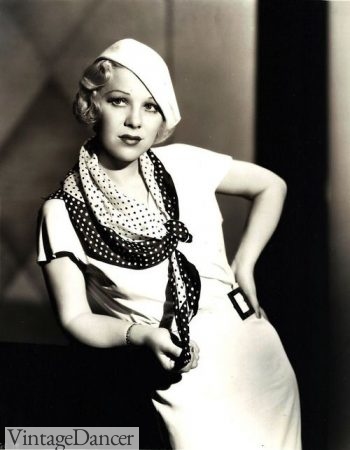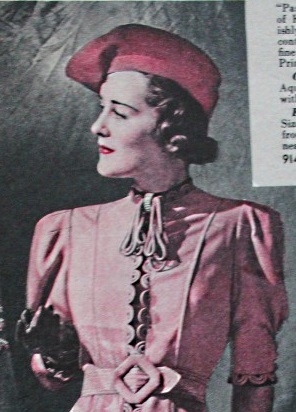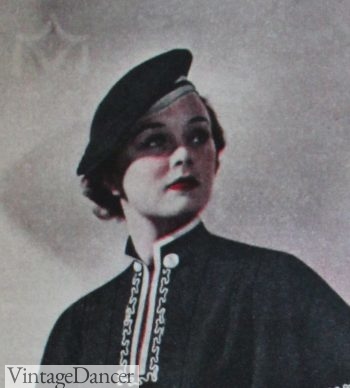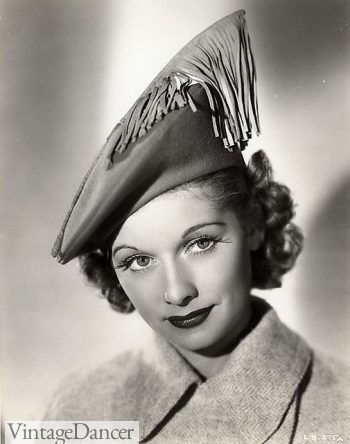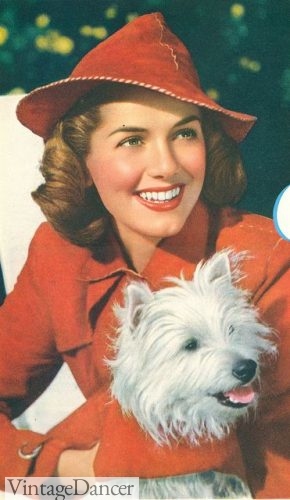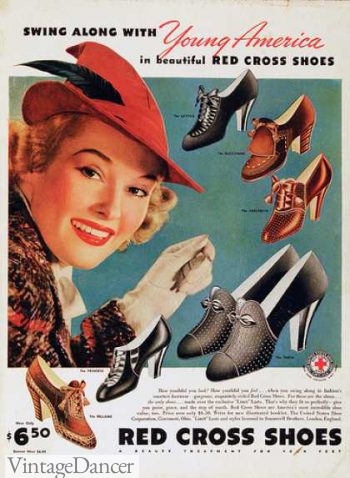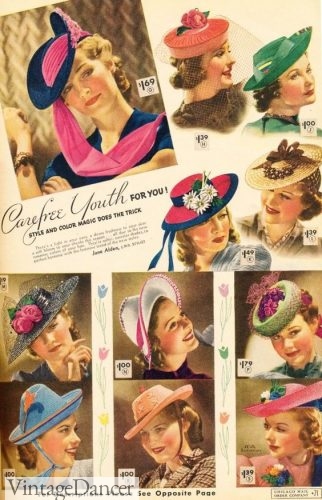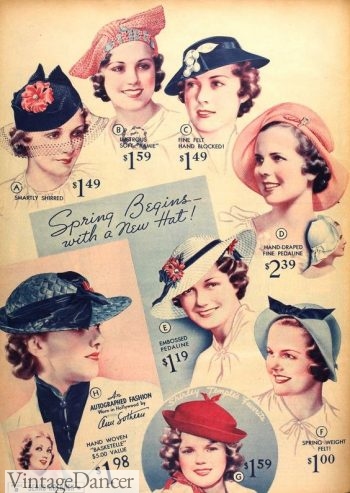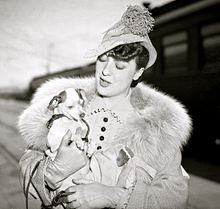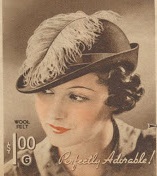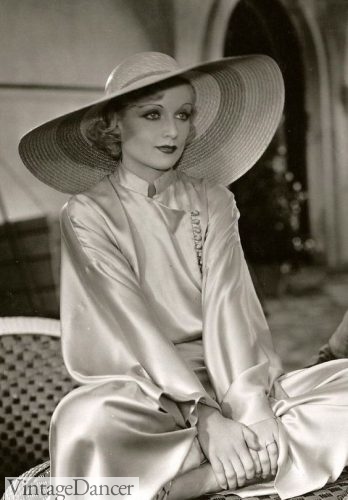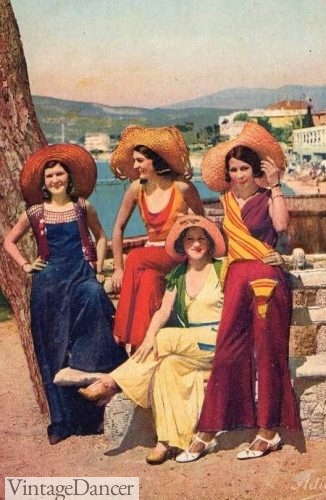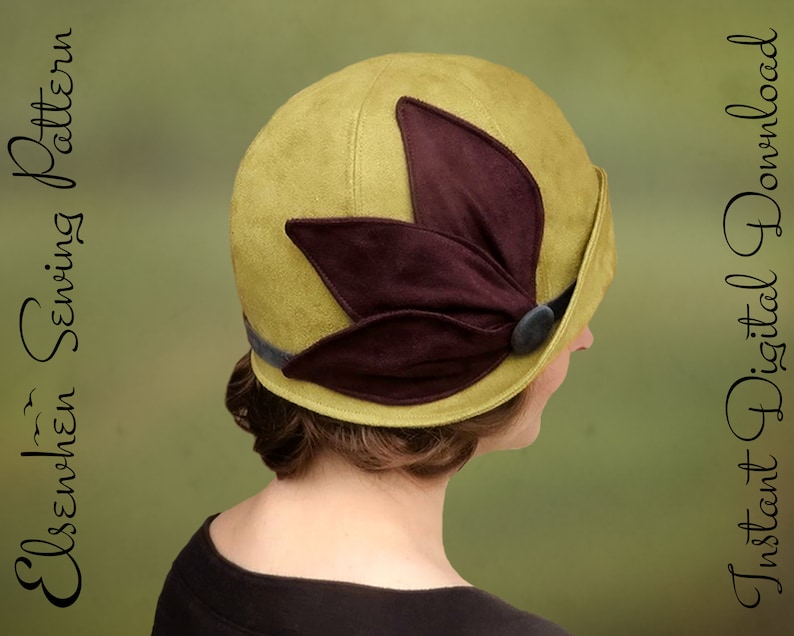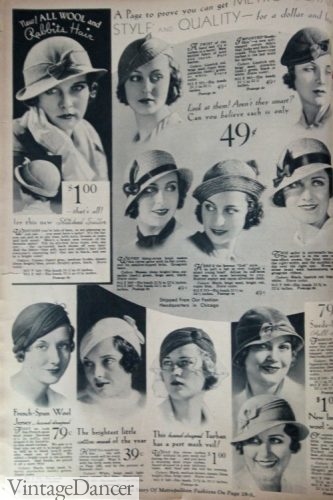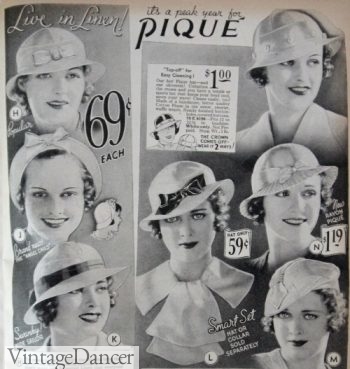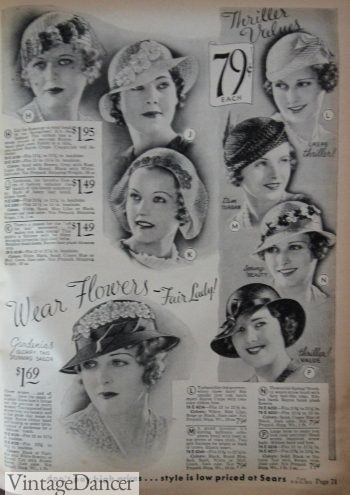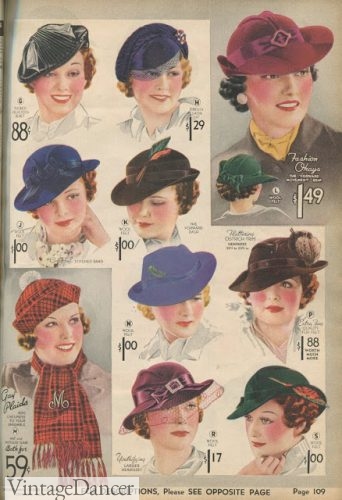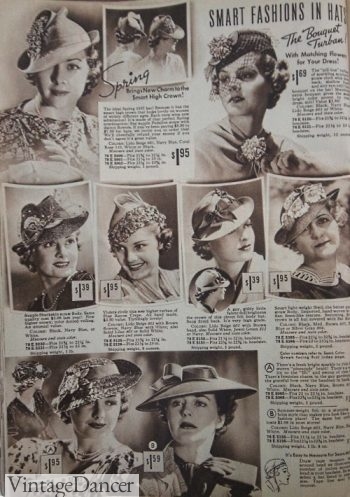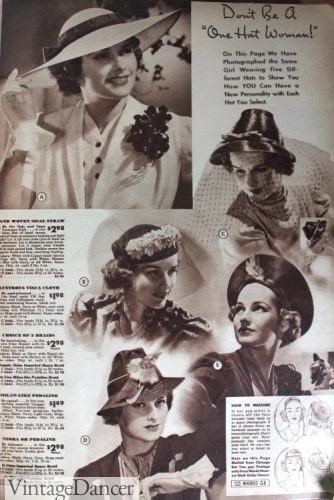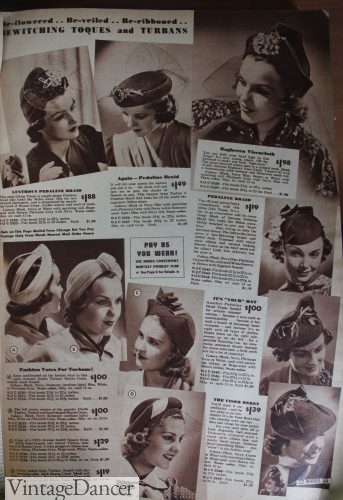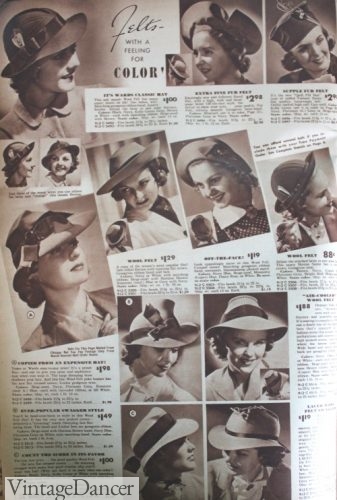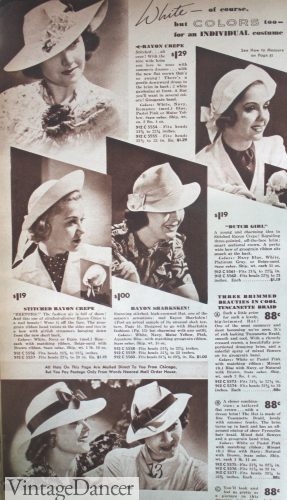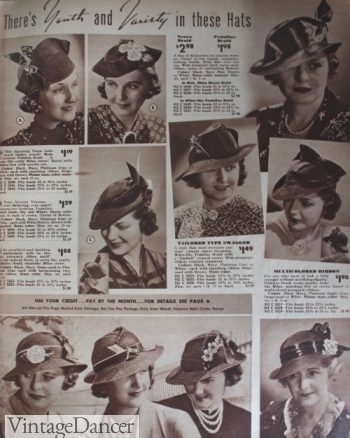What the 1920s did for womenswear, generally, the 1930s did for hats. The Jazz Age restructured traditional silhouettes into more liberated form, setting the stage for hatters like Schiaparelli and co. to experiment with ever-madder designs. For all its scandalous sartorial variety, the 1920s played it safe in the hat department, sticking mostly to cloches — dismissed by Vogue as “alike as two million peas.” The next decade, though, was one of whimsy.
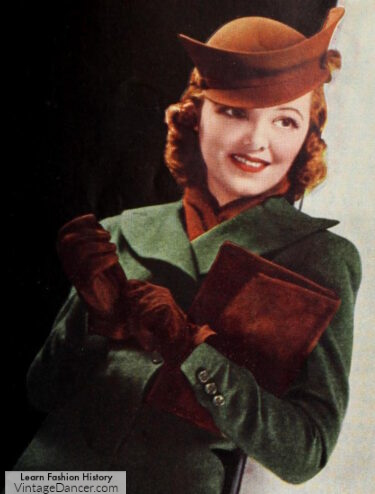
1938 fall outfit with unique felt hat
In the privation of the ‘30s, everyone needed a little mischief. “Hats are more hilarious than ever this year. If they don’t vanquish the Depression, nothing will.”- Fashion Arts, 1925.
Ladies 1930s hats were cheerful, quirky, and feminine, even while taking style cues from men’s hats.
Key 1930s Hats Styles
In the 1930s, women wore a variety of small hat styles including slouch hats, berets, turbans, fedoras, as well as wide-brimmed picture hats. Wearing a hat completed an outfit as well as provided modestly and respect in Church and social settings. This is why most women would never leave the house without wearing a hat in the 1930s, unless in very casual clothing or for eveningwear.
- Cloche hats – tight fit on skull, narrow brim
- Slouch hats – Rolled back brim cloches
- Shallow crown small hats perched at a deep angle
- Madcaps – Soft draping berets
- Men’s fedora hats soften for women
- Large round cartwheel or picture hats for summer
- Historical inspired hats and caps
- Velvet turbans, gold evening turbans
- Veiled hats
- Pointed crown hats
- Suede, fabric, knit hats and caps
1930s Hats History
1930s Cloche and Slouch Hats
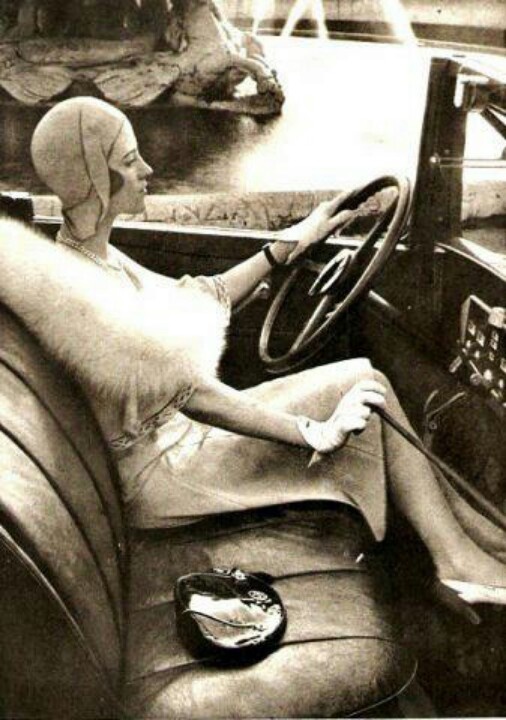
1931, cloche / slouch hat
The 1930s began with the restructuring of the cloche. In the late 1920s, brims began to widen, the better to accommodate the new longer hairdos. Soon to follow were the pleats, veils, and asymmetries of the next few years. The hats of the early 1930s fit close to the head, as their earlier counterparts had, but their silhouettes grew steadily more elaborate.
“From the late 1920s into the early years of the next decade, the folding and piecing techniques used on felt or lightweight straw hats in some ways mimicked the constructions of bais-cut dresses.” Hats by Fiona Clark
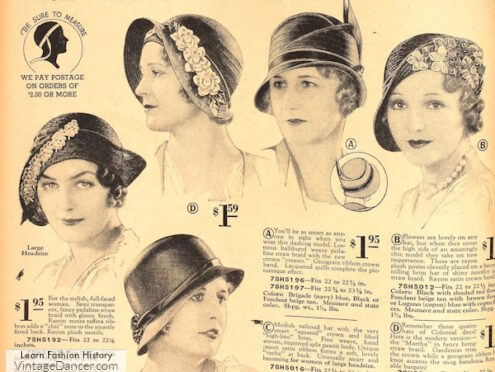
1932 cloche hats with shaped brims to the side
Floppy and asymmetrical cloches of the late ’20s and early ’30s drooped around the head and neck, but exposed the forehead. Floppy sun hats also fit snug around the crown but framed the face in gentle curves.
These styles gave way to a smaller hat, not shaped with a hatform but with a manipulation of folds, tucks, and piecing. They were cheerful little things, echoing the sentiment that “Happy Days Will be Here Again.”
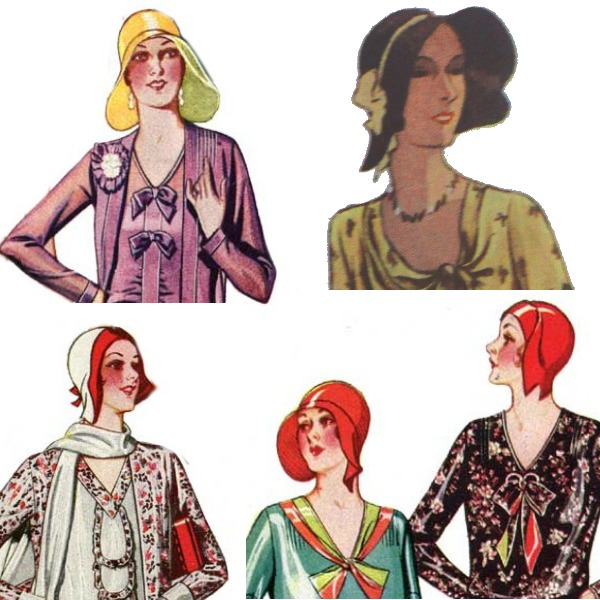
1930s slouch hats or cloche hats
The ’30s cloche also became known as the Garbo slouch hat. It was designed by Gilbert Adrian and worn by Greta Garbo in Woman of Affair, 1928.
Slouches and sportsters were a Garbo favorite hat style outside of the theater as well. Prior to her acting career, she had worked as a milliner’s assistant. She understood the artistry in hat making, but also the gentlemanly poise it took to wear a men’s hat style with grace.
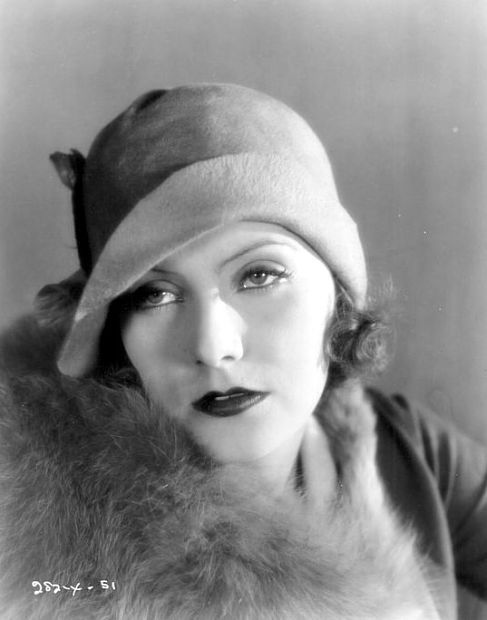
Greta Garbo’s slouch hat
These updated cloche hats were free of most decorations. The beauty was in the fabric manipulation and the addition of a single solid or striped grossgrain band. By 1933, they began to feature small visors, pulled down and forward like a Jockey’s cap. Some top stitching added interesting details and perhaps the addition of one or two small felt flowers or a bow on spring hats.
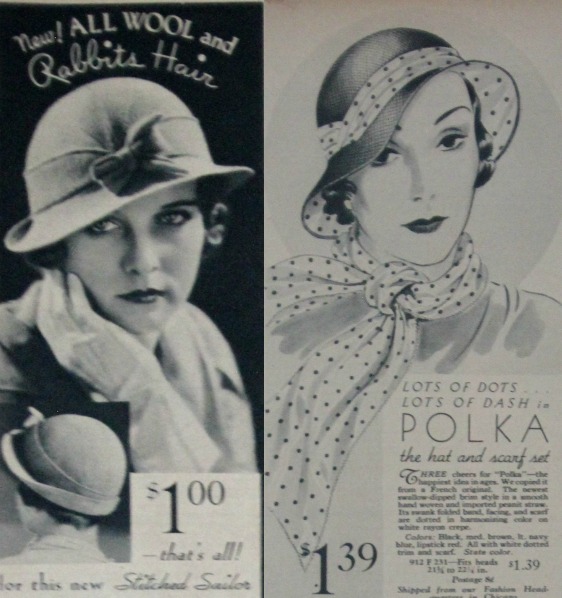
1933 brim slouch hats
1930 Madcap Beret Hats
Elsa Schiaparelli’s “madcap,” a knit hat that could be shaped and stretched according to each wearer’s preference, debuted in 1930, auguring the decade’s experimental spirit. It was an international success.
Madcaps could be made of linen silk, wool, or chenille. Many women made these simple 1930s hats at home, although they could also be bought for 35 cents instead of the usual $1-2 price for felt hats.
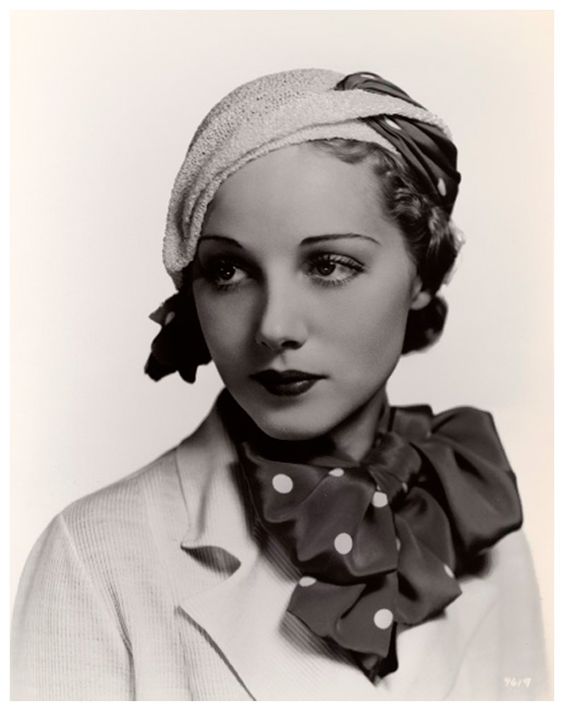
1930s mad cap
The knitted cap birthed other classic designs now crocheted with a yarn that was blended with stretchable rubber Lastix. Bonnets, berets, tams, sailors, and turbans were successful styles made of this new technique. Knitted crowns were also paired with solid brims of felt or straw. A hybrid 1930s hat for spring and fall.
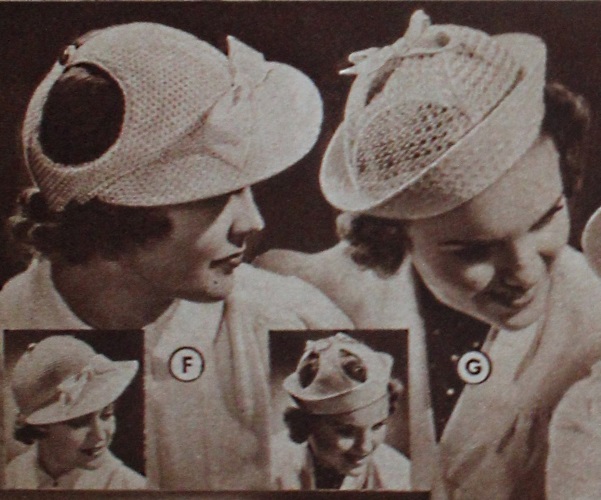
1938 open crown knit Jocey cap and sailor hat
Beret hats, another ‘20s holdover, got increasingly bigger, and their angles jauntier. Many swooped up high in the back and low in the front. Stiff visors kept many of the largest berets from flopping too much, while others embraced the flop over one eye. Actress Marlene Dietrich was known for her beret hats paired with men’s suits.
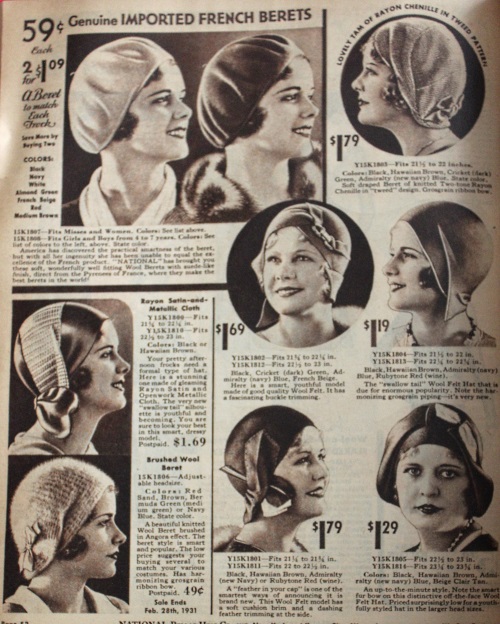
1931 beret hats and soft brimless cloches
- 1934 angled beret hat
- 1937 red beret hat with flop to one side
- 1937 french beret hat
- Lucile Ball stiff top beret with fringe feather
1930s Turban Hats
Tams, toques, and turbans rounded out the early ‘30s repertoire. When gold was devalued, the fashion industry jumped at every opportunity to use it. Gold glittery turbans made of lame or metal cloth not only were seen in the evenings but shimmered with some rich daytime outfits. A lamé turban, fur coat, and gold studded gloves was a wealthy city woman’s signature style.
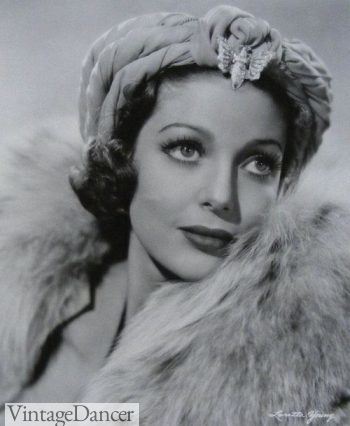
Loretta Young, 1937, wearing a Turban hat with a butterfly pin
The turban was so popular in the evenings and for the new-ish “cocktail hour” that they were being made of brocade, velvet, batik, and metal infused crepe. Some took on the looks of Grecian Goddesses, while others taped the trend of Eastern maharanis styles.
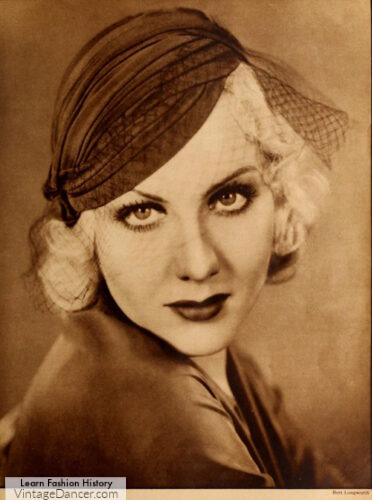
1933 Mary Brian wears a turban beret hat
In the later 1930s, some hats took the swathed shape of the Turban and combined it with felt, straw or braid for a hybrid Turban hat. Structured hats were replacing the softer styles of the early ’30s.
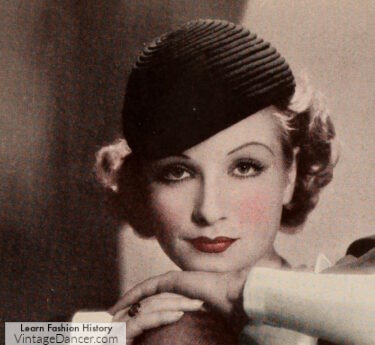
1933 Sari Maritza wears a Juliet cap, a cousin of the turban
1930s Small Hats
As the Depression deepened, fewer materials had further to stretch than ever before. Led by Schiaparelli and her ilk, fashionable women made the very most of what they had, contorting simple shapes into hundreds of variations.
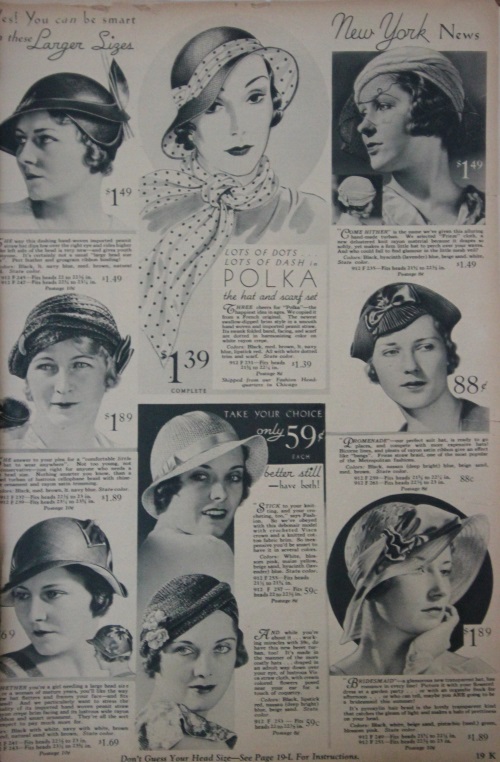
1933 hats – knit caps, stiff turbans, soft Turban and picture hat
Small, shallow-crowned hats were often adorned with veils and grosgrain ribbons, which brought a touch of the feminine to an otherwise utilitarian wardrobe. Veils came down to the eyes, nose or chin – just enough to shade the eyes and add a touch of mystery.
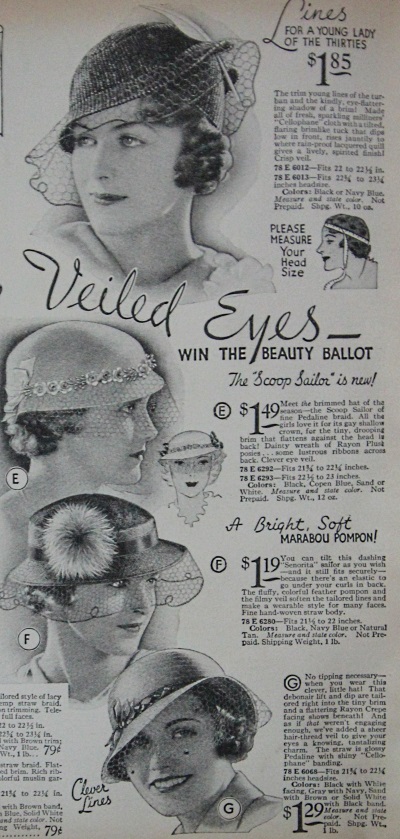
1934 veiled hats
To secure hats to heads, elastic bands were placed under the hair. Other styles extended a flap to the beck (bobby pins secured it even more). Most thirties hats were not lined, but a thin grosgrain ribbon circled the inside.
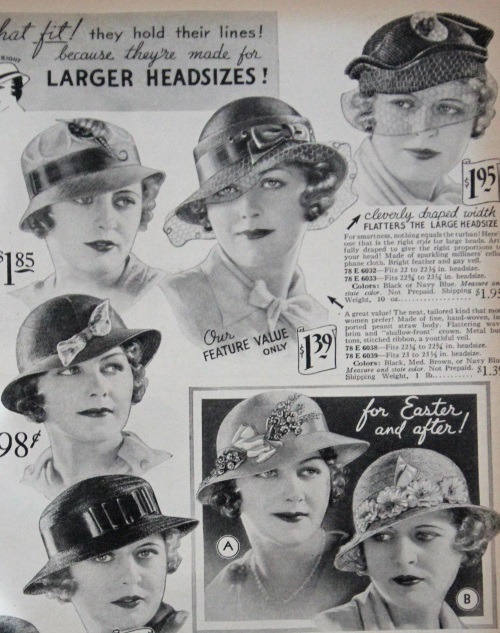
1934 hats with veils, ribbon trim, and flowers for “larger heads”
In the decade’s second half, silhouettes began to diversify. Bolstered by the economic upturn of 1934, milliners debuted a dizzying variety of shapes, sizes, and materials. The hats of the late 1930s were a preview, a microcosm, of trends to come.
From the ‘40s fedora to the Jackie O pillbox, headgear trends of the next thirty years were previewed between 1934 and 1939.
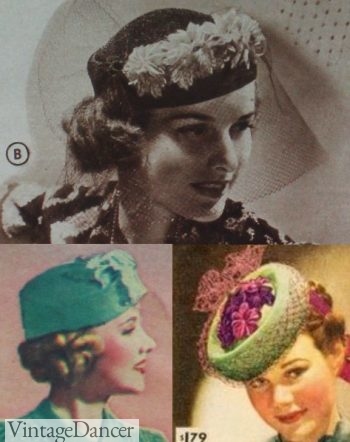
1930s pillbox hats
1930s Sporty Hats
A menswear influence brought the fedora, bowler, Panama, and boater hat to women’s fashions. Bicorns, tricorns, and sailors took notes from men’s military styles. Many men’s hatters started to produce women’s hats to complement their men’s lines.
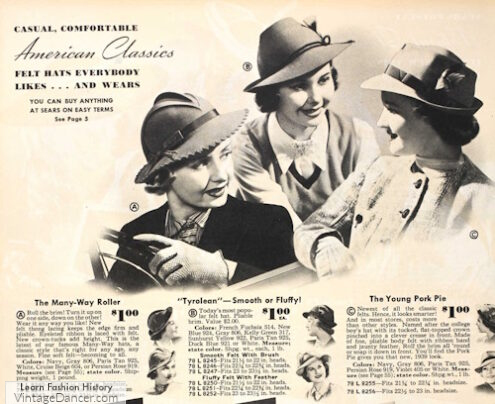
1939 Roller, Tyrolean, and Pork Pie hats for women
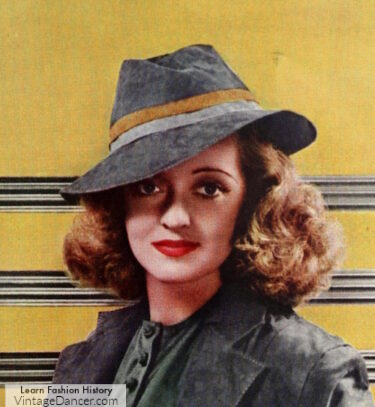
1938 suede hat
Each of these tailored designs remained soft and feminine, unlike the later masculine shaped ’40s hats. These “sport hats” paired well with any daytime ensemble, from tweed suits to floral dresses.
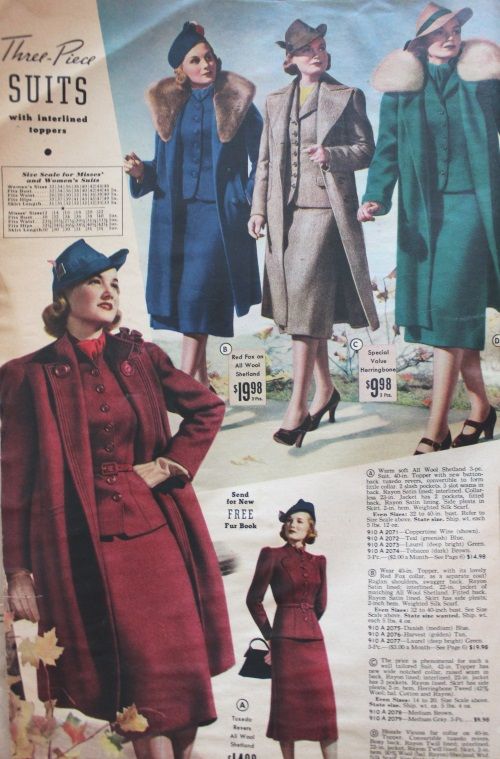
Ladies man-tailored hats with suits
The late ’30s fedora hats grew taller and more complex. In 1935, the hat raised high over the head, albeit worn pulled down and to the side at a jaunty angle. The many folds and points gave it a feel of origami instead of the simpler men’s fedora hat.
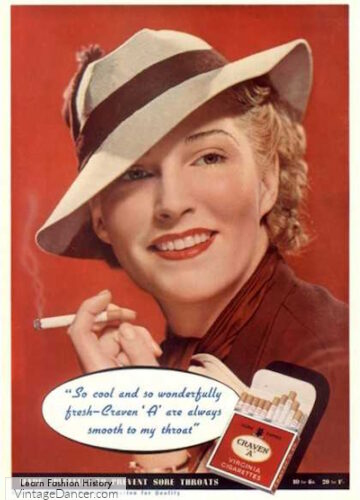
1936 tailored felt hat
In summer, the men’s Panama hat gave way to a woman’s version, It was made of fine white Panama straw shaped into a ladies’ summer hat. Crowns were round with a wider brim and a bow or band. The femininity was in the waved shaping of the brim.
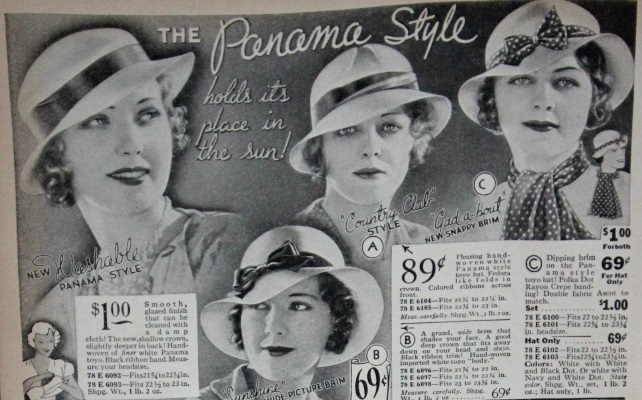
1934 panama straw summer hats
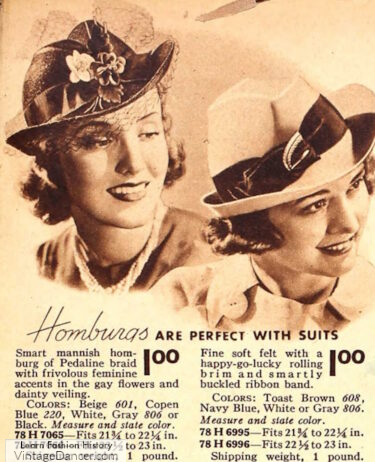
1938 ladies Homburg hats
1930s Historical Hats
A Renaissance revival brought snoods in jewel-toned velvets. Snoods were worn for everything day to night, sporty to elegant.
The Juliet cap was named from Romeo and Juliet. It had been an eveningwear hat in the 1920s that continued into the ’30s with a smaller version, usually with wimples and a chin length veil.

1933 Sari Maritza wears a Juliet cap
Other Renaissance inspired hats, especially those made of colored velvet, were extremely popular.
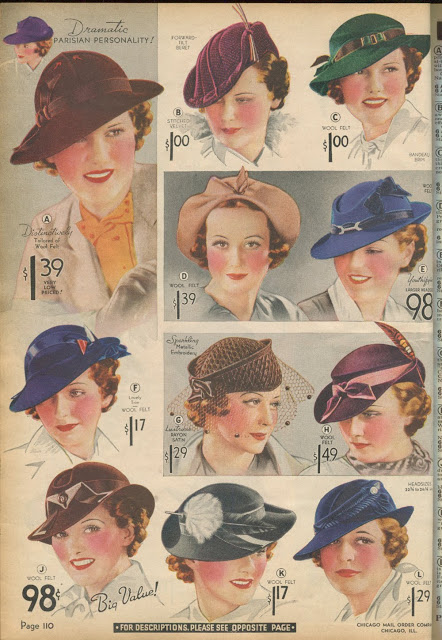
Late 30s hats with decoration inspired by the historical past
The Napoleon silent movie inspired a wave of trims such as tassels, pompoms, rosettes, soutache, braid, frog closures, epaulets, and brass buttons. They looked best on Napoleon era hat shapes such as the tricorn, bicorn, soldier hats, and Citizen Jacobin caps.
- 1939 Robin Hood Hat
- 1930s Tyrolean Hat with Feather
New shapes emerged, such as the pointed Robin Hood Tyrolean. It had a pointed crown and feather pointing out of one side. The single feather was a popular element on many styles of ladies’ sport hats. Its sharp angle and stiff nature mimicked those shapes found in Art Deco architecture.
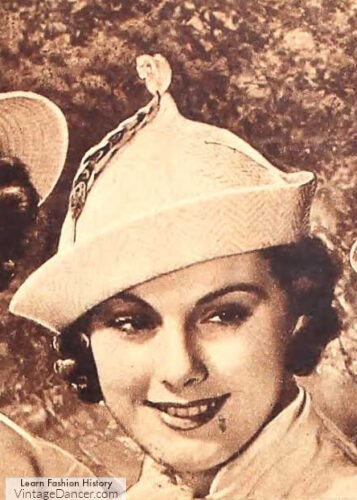
1936 pointed crown hats are iconic to the 1930s
Not to forget that Robin Hood rescued the poor the peasant kerchief scarf closely wrapped the head and tied under the chin. Bad hair day? Wear a kerchief! See more here.
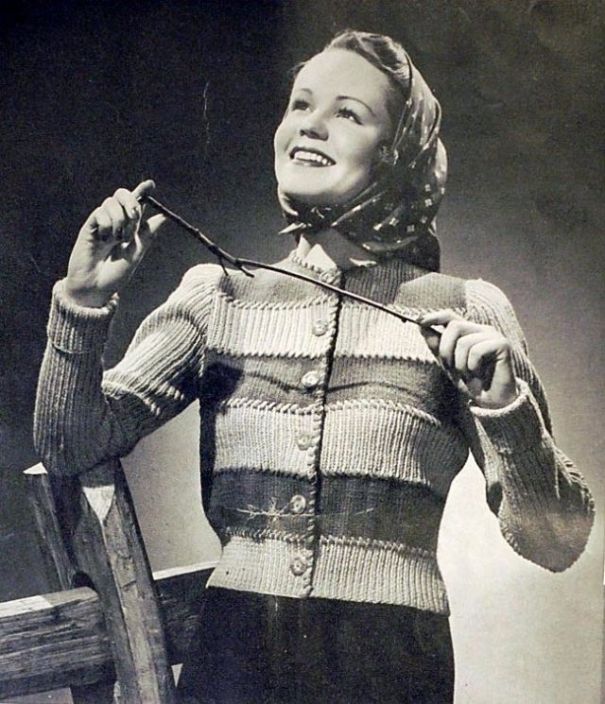
1930s kerchief hat
Fur Cossack caps also made a nice winter hat. They and fur caps complete with tails were inspired by Davy Crocket and Daniel Boon American movies.
Sailor hats were big deal around 1935, especially when made in blue with poppy pink decoration They were worn straight on the head with the simple sailor hat shape, but topped with fussy frills, pleats and ribbons. Plain sailor hats were the ideal look for casual summer beach clothes with nautical themes.
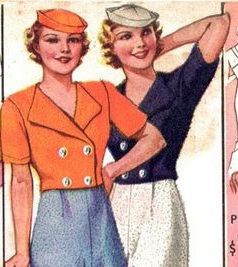
1934 sailor hats
The late 1930s saw new shapes, more trim, and brighter colors enter the millinery world. Brims broadened considerably from the close-fitting iterations of the early ‘30s.
Small saucers, platters, and fruit-topped cartwheels became a staple for day by 1938. Some were especially small, doll-sized hats, that sat tilted forward on the crown. Feathers, flowers, fruit and bows topped these little hats, raising the eye away from the face and onto these whimsical accessories.
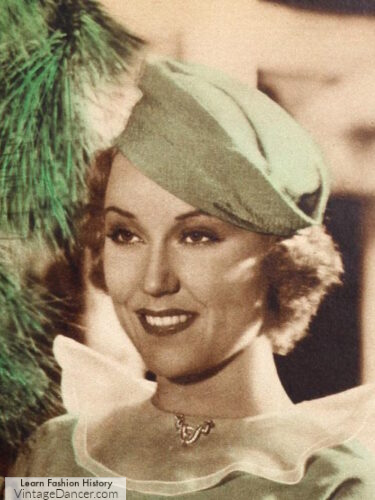
1933 Fay Wray tilted small hat
In general, late ’30s hats were an explosion of contrasting colors and ample fussy decorations. Blue, pink, green, and peach made up most spring and summer hats.
- 1939 spring hats
- Late 1930s Day Hats
1930s Hollywood Hats
The film industry, as it developed over the decade, broadened the American imagination like never before. With each new release, every man and woman peeked into new and exotic worlds, which influenced popular aesthetics.
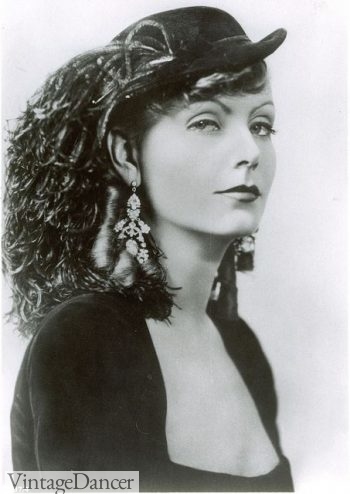
Greta Garbo’s Eugenia Hat in Romance 1930
Period dramas introduced a series of Victorian-inspired hats, most memorably the Empress Eugenie hat worn by Greta Garbo in Romance (1930). It was tiny felt hat decorated with a single ostrich feather, worn at a tilted angle over one eye. Called the EE, it took inspiration from a riding hat worn by the Empress.
Over the top, asymmetrical, and a subject of negative commentary, the EE lost favor as quickly as it began. However, it influenced many other hat designs over the decade.
- An EE hat modeled by Gypsy Rose lee
- 1930s Ostrich feather EE or bowler style hat
The Victorian bonnet was also revived in a 1930s style as well as the large picture hat when it was worn by Mae West in She Done Him Wrong (1933). Also called cartwheel hats, these giant, stiff-brimmed circles dramatically offset the straight dress lines of the mid 1930s.
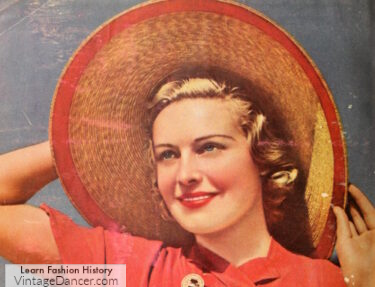
1937 straw cartwheel hat
Up to 17 inches across, they were difficult to wear in the city, but a welcome sight on a sunny vacation or ride into the country. They were not only made of smooth or rough straw but also revived in old fabrics like gingham.
- Carole Lombard’s cartwheel hat
- 30s straw cartwheel hats and beach pajamas
Smaller 1930s hats, called Picture hats or Halo hats, circled ladies’ heads in summer. They were a more reasonable size and made with prettier materials. Loretto Young sported the Halo hat on many occasions, giving it some famous attention.
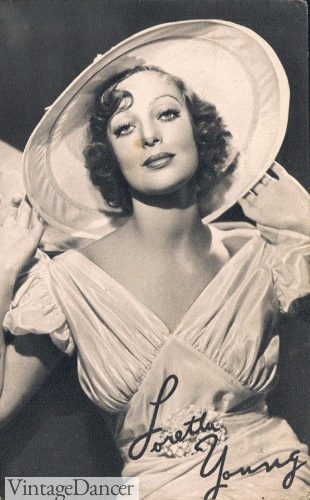
Loretto Young and her iconic Halo Hat
30s Halo hats were shallow crowned with a large circle brim and simple decoration such as a single bow band or cluster of flowers on one side.
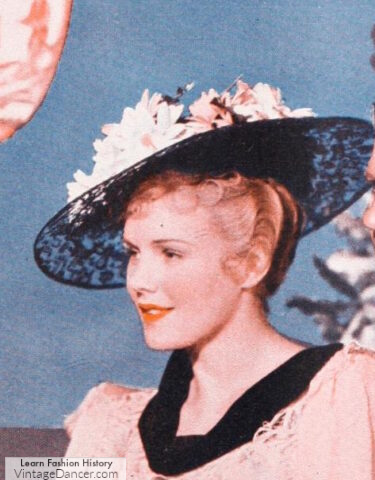
1936 lace and flower tea hat
Other exotic blockbusters inspired cowboy hats, Oriental turbans, and swashbuckling bicornes and tricornes. Hollywood influence begat a truly American school of hat design, as milliners marketed hats inspired by — and named for — the stars who had worn the silver-screen originals.
Greta Garbo, Shirley Temple, and Marlene Dietrich, among others, lent their names to Sear’s “authentic movie styles” line. For example, Shirley Temple wore Scotch caps or Glengarry. They were popular with children and teens.
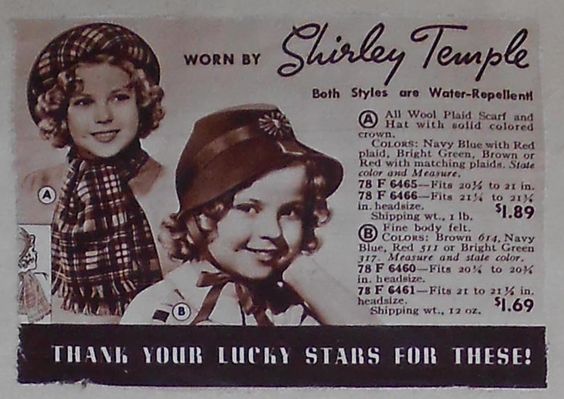
Shirley Temple Hats
More 1930s hat styles
The Derby – modified from men’s hardtop hats the softer, shapely riding derby was worn on and off horses.
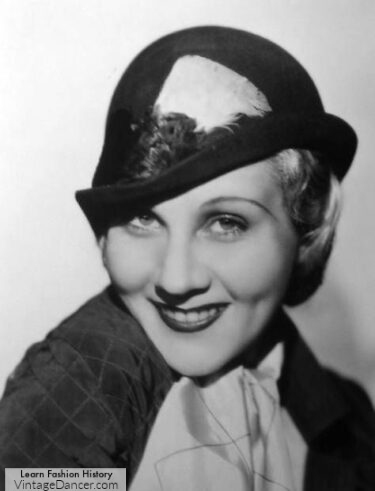
“This new millinery, an Empress Eugenie riding derby, is selected by Judith Wood. It is of navy blue felt trimmed with blue and white feathers.” 1931
The roller hat was a small 1930s hats with a shallow crown and rolled up brim.
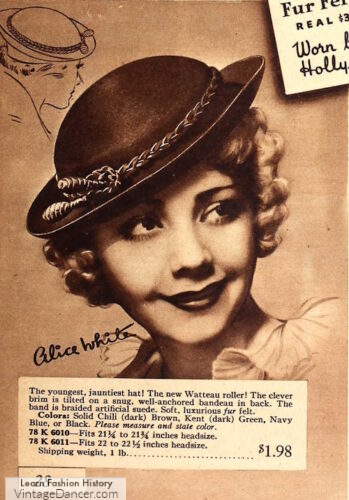
1935 roller hat
Buying 1930s hats today
While it is possible to buy vintage 1930s hats, they are quite expensive and usually not in one of the most classic ’30s styles. When I need to dress in a ’30s style, I look for small shallow crown hats that a wear at an angle.
Cloches work well for an early ’30s look, as well as velvet Turbans for an evening style. Berets and small fedoras are great for a sporty look, while summer straw hats look great in warm weather.
If you have some millinery talent, you can take any felt hat and reshape the brim into the classic ’30s wave. You can also sew many 1930s hats following a hat pattern such as these.
